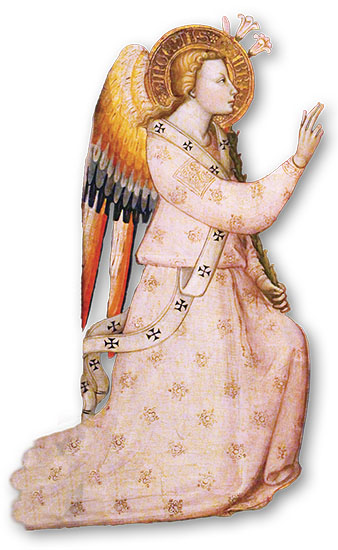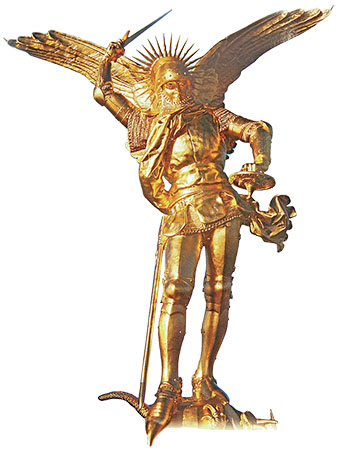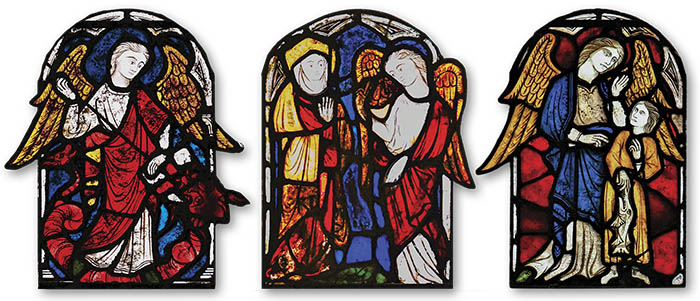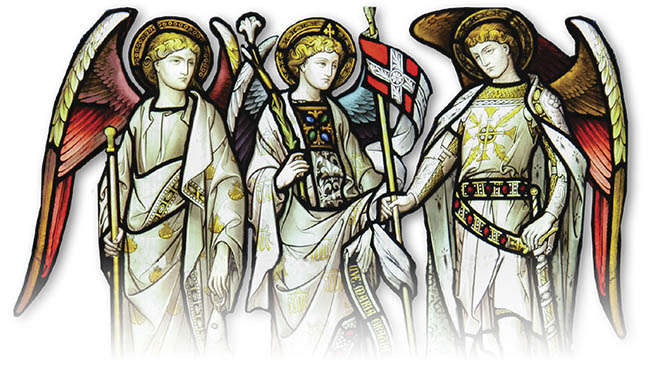We may ask ourselves what relationship exists between the respective roles of the three Archangels: St. Michael, St. Gabriel and St. Raphael.
They seem to constitute a kind of closed circuit, a totality, in the manner of a trinity. How is this “trinity” linked to the entire angelic world? All the more so because, to estimate the mission and importance of each one, two different orders of values come into play: one is what they are by nature; the other is their conduct during the trial, because, without a doubt, all three acted perfectly on that occasion.
But perfection has degrees and one sees, for example, that St. Michael was super-excellent when put to the test. I was told that St. Louis-Marie Grignion de Montfort claims that he showed the greatest love for Our Lady, and was therefore the most combative. This is a primacy owing to his attitude during the trial, which is different from primacy by nature.
We will deal here only with the relationship of nature to nature, without considering the effective primacy as it exists in Heaven, in view of the reaction during the trial. We must analyse what the three Archangels do and how they act in order to understand how they complement one another in this triad.
St. Gabriel: loving knowledge

St. Gabriel is the one who communicates the knowledge of God, and from this we can understand his role in the Incarnation. St. Raphael helps men in the difficulties of life, and St. Michael assists them in the struggle. What relation, then, is there between the modes of being of these Angels?
The knowledge of St. Gabriel is, of course, all loving; it is not a pure abstract, theoretical and doctrinal knowledge.
It should be noted that man’s knowledge concerning a given point is entirely complete when he is able to formulate in words or express in some other way what he has in his mind. As long as there is no such representation, knowledge is incomplete, and therefore neither is the act of love complete.
Moreover, it is only after an individual has finished attaining the essential knowledge of something that he decides to act, facing the greatest difficulties and consecrating his life to it. That is, the consecration of work and of life constitutes a kind of deliberation that comes from an already active, implementing knowledge, which is the final term of knowledge.
Finally, no one knows something entirely if he does not understand it by contrast. Not to notice the contrast, when it exists, reveals a great lack of knowledge.
There is, therefore, a speculative and loving knowledge that elicits action, and a knowledge that summons to combat. The first does not invite one to merely speculate, but also to express what one feels. It is a contemplation from which emanates the word, of an awareness that acquires its light by being verbalized. Therefore, exclamation is proper to fully developed knowledge, to love fully attained, which blossoms in the canticle of selfless praise.
Therefore, we could say that the three Archangels form, in the speculative order, three manners of action, inasmuch as action is less evident in the one who is higher in the speculative order, and speculation presents itself less in those who are placed in the active order. There is a kind of inverse relationship, like that of Mary and Martha.
St. Michael: struggle, oblation and holocaust

One might believe that I am preparing the ground to present the figure of an equilateral triangle, in which the angle at the top would represent St. Gabriel, and the two at the bottom, in equal positions, St. Raphael and St. Michael.
But this is not true, for, depending on the angle from which one looks, in this equilateral triangle any one of the three Archangels may occupy the upper point without the polygon being unbalanced, which seems especially clear in the case of St. Michael. Why? Because involvement in the fight entails something destructive for the one who fights. Even when the individual does not die in the fight, or when the normal development of the fight does not result in death, fighting implies making an effort that is completely superior to the normal wear and tear of the organism; in itself it is consuming; it has something of an oblation.
Let us consider the example of a man who must bring a muzzled jaguar to the zoo. He is not going to be swallowed by the jaguar, but he approaches it to be struck and strike, and such a degree of exertion is involved in taking the animal that he is considered a fighter. This man receives a certain glory because of a kind of immolation that exists in that act.
Now Our Lord said that immolation constitutes the greatest proof of love: no one can love another more than by giving his life (cf. Jn 15:13). In reality, this is self-evident, and the Redeemer said it of Himself in order to explain how we ought to be certain of His love for us.
On the other hand, it is also true that this is the most selfless oblation. When Abraham was willing to immolate his own son out of obedience to God, he showed tremendous selflessness; it was an act of pure love. And one can fight for pure love, going, for example, to a Crusade, as Isaac went to be killed by his father.
Oblation, in this sense, is the extinction of one’s life in holocaust to another – to God, therefore.
We see then that, as beautiful as St. Gabriel’s words are, when we consider the magnificence of St. Michael’s fight we perceive this to be another title of glory, and we are left wondering which of the two titles, absolutely speaking, is greater.
St. Raphael: thoughtful action
Here action enters into the picture, and action seems far inferior to contemplation and to the fight, to oblation.
But one might even say that action is a struggle. In this sense, when a City Hall employee leaves the house and his wife asks “Where are you going?”, he replies: “I am going into the fray.” However, such usage is explained in view of a very material conception of action.
As regards St. Raphael himself, what remains in our minds, at least for me, is the quaint and ingenuous drawing that illustrated my Sacred History: the Archangel walking along with a staff from which hung a kind of jug, and chatting cheerfully with Tobias. He would thus be the Angel who walks, who covers long distances.
This is not the whole truth. St. Raphael manifested a superior active wisdom, which helped Tobias to see what his aims should in fact be on the journey, and which gave him strength and encouragement – this is the meaning of company – while providing him with the means to reach his destination. The material aspects of the journey were nothing to the Archangel – traveling on foot, making the speaking figure that he took on, and which Tobias took to be a man.
Clearly, then, in order to speak of St. Raphael as the Archangel of action, we must refer to the highest degrees and standards of action. That is to say, much more than fully active operational action, we are talking about thoughtful action. To use a real-life example, we may illustrate with a phrase attributed in several different forms to Marshal Foch: “Ma droite est pressée, ma gauche est menacée, ma arrière est coupée… Que fais-je? J’attaque.”1 That is magnificent! In other words: “I am in a total bind; I will attack!” One could call this a “Raphaelic” action, in that sense of the word, which demonstrates thought over action, a lofty category of action.

The role of each Archangel in relation to man
Thus, the art of governing, of directing action prophetically, would be with St. Raphael; to St. Michael would correspond prophesy in the fight and in the holocaust, and not in common life; and the regency would correspond to St. Raphael. Here we understand the beauty of the distinction between the various missions.
St. Gabriel is the prophet who inspires the king; he outlines the metaphysical action. The one who provides the “metapolitics” – understood as the highest aspect of the directive function – is St. Raphael. The one who engages in the “metafight”, with the special task of repelling the demons, is St. Michael.
As counter-revolutionaries, what is the role of the three Archangels?
I would say that St. Gabriel inspires the truly counter-revolutionary spirit, with the whole ideal of the Reign of Mary, with the desire and conception of the most sublime things, in such a way that he gives us an idea of the fundamental features of how human order should be.
Starting with this supreme order, what is the modus operandi for organizing it? What are the means to bring it into effect? It is St. Raphael who specifies them.
And to fight against the adversaries who oppose it is the mission of St. Michael.
Transposing this idea to the human field, we see that St. Louis-Marie Grignion de Montfort, for example, had “Gabriel-like” moments, “Raphael-like” moments and “Michael-like” moments, depending on the preponderance of one or another aspect in his mission.
We sense this in reading the Treatise on True Devotion to the Blessed Virgin. There are passages where we have the impression that it is St. Gabriel who is announcing some sublime truth. When St. Louis, as an apostle, builds up the argumentation to convince a third party and enkindles a spiritual fire to call him, St. Raphael transpires. In the movements of indignation, because there is an adamantine intransigence in his book from beginning to end, it is the hour of St. Michael. That is to say, there are keynotes.

Which angelic aspect shone most in the life of Our Lord?
Such considerations do not obviate the deeper problem of knowing which of these aspects, absolutely speaking, is the keynote in God. We might ask which of them shone most in the most holy and august life of Our Lord Jesus Christ, and on what occasions He conducted Himself as the God of Gabriel, the God of Michael and the God of Raphael. Enquiries of this nature would give rise to a most beautiful study of the Gospel.
I would say, for example, that His intimate life with Our Lady, or His Transfiguration on Mount Tabor, appear to be eminently connected with St. Gabriel.
His Passion, evidently, has more to do with St. Michael. It is the moment of holocaust and of struggle, when He conquers the world. Agony, in Greek, means struggle of the athlete; the athletes were called agonists.
And St. Raphael is associated more with His public life, with the Teacher doing apostolate.
It is very enlightening for the soul to reflect on these problems. They shed light even when we do not solve them. And if after thinking like this we consult a book on Angelology, in ten minutes the question is clarified.
In my opinion, it would be in accordance with our mental methods – without saying it is the only way – and I think that Our Lady blesses this approach: to first try to make hypotheses with the light that She has given us, and then to study what the Church teaches, in a spirit of submission, of desire to learn. And then theology is well understood. This seems to me a very worthy and very correct way to proceed, and it is what I have tried to do in this conference. ◊
Taken, with adaptations, from: Dr. Plinio. São Paulo. Year XIX. N.222 (Sept., 2016); p.26-31
Notes
1 From the French: “I am pressed from the right, I am threatened from the left and I am cut off from the rear… What do I do? I attack!” Marshal Foch was a French military officer who decisively commanded the Allied forces during the First World War, leading them to victory.


